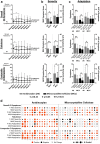Adaptation to tolerate high doses of arabinoxylan is associated with fecal levels of Bifidobacterium longum
- PMID: 38860973
- PMCID: PMC11174067
- DOI: 10.1080/19490976.2024.2363021
Adaptation to tolerate high doses of arabinoxylan is associated with fecal levels of Bifidobacterium longum
Abstract
Dietary fiber supplements are a strategy to close the 'fiber gap' and induce targeted modulations of the gut microbiota. However, higher doses of fiber supplements cause gastrointestinal (GI) symptoms that differ among individuals. What determines these inter-individual differences is insufficiently understood. Here we analyzed findings from a six-week randomized controlled trial that evaluated GI symptoms to corn bran arabinoxylan (AX; n = 15) relative to non-fermentable microcrystalline cellulose (MCC; n = 16) at efficacious supplement doses of 25 g/day (females) or 35 g/day (males) in adults with excess weight. Self-reported flatulence, bloating, and stomach aches were evaluated weekly. Bacterial taxa involved in AX fermentation were identified by bioorthogonal non-canonical amino acid tagging. Associations between GI symptoms, fecal microbiota features, and diet history were systematically investigated. AX supplementation increased symptoms during the first three weeks relative to MCC (p < 0.05, Mann-Whitney tests), but subjects 'adapted' with symptoms reverting to baseline levels toward the end of treatment. Symptom adaptations were individualized and correlated with the relative abundance of Bifidobacterium longum at baseline (rs = 0.74, p = 0.002), within the bacterial community that utilized AX (rs = 0.69, p = 0.006), and AX-induced shifts in acetate (rs = 0.54, p = 0.039). Lower baseline consumption of animal-based foods and higher whole grains associated with less severity and better adaptation. These findings suggest that humans do 'adapt' to tolerate efficacious fiber doses, and this process is linked to their microbiome and dietary factors known to interact with gut microbes, providing a basis for the development of strategies for improved tolerance of dietary fibers.
Keywords: Adults; Bifidobacterium; arabinoxylan; dietary fiber; gastrointestinal symptoms; gut microbiome; short-chain fatty acids; tolerance.
Conflict of interest statement
ECD was a previous employee of AgriFiber Solutions LLC (Illinois, USA). JW has received research funding and consulting fees from industry sources involved in the manufacture and marketing of dietary fibers, including AgriFiber Solutions LLC. JW is further a co-owner of Synbiotics Health, a developer of synbiotic products. These interests did not influence his judgement or presentation of study findings. All other authors declare no conflict of interest.
Figures






Similar articles
-
Gut microbiota modulation with long-chain corn bran arabinoxylan in adults with overweight and obesity is linked to an individualized temporal increase in fecal propionate.Microbiome. 2020 Aug 19;8(1):118. doi: 10.1186/s40168-020-00887-w. Microbiome. 2020. PMID: 32814582 Free PMC article.
-
Elucidating the role of the gut microbiota in the physiological effects of dietary fiber.Microbiome. 2022 May 13;10(1):77. doi: 10.1186/s40168-022-01248-5. Microbiome. 2022. PMID: 35562794 Free PMC article. Clinical Trial.
-
In Vitro Fecal Fermentation Patterns of Arabinoxylan from Rice Bran on Fecal Microbiota from Normal-Weight and Overweight/Obese Subjects.Nutrients. 2021 Jun 15;13(6):2052. doi: 10.3390/nu13062052. Nutrients. 2021. PMID: 34203983 Free PMC article.
-
Relative abundance of the Prevotella genus within the human gut microbiota of elderly volunteers determines the inter-individual responses to dietary supplementation with wheat bran arabinoxylan-oligosaccharides.BMC Microbiol. 2020 Sep 14;20(1):283. doi: 10.1186/s12866-020-01968-4. BMC Microbiol. 2020. PMID: 32928123 Free PMC article. Clinical Trial.
-
Structure-dependent stimulation of gut bacteria by arabinoxylo-oligosaccharides (AXOS): a review.Gut Microbes. 2024 Jan-Dec;16(1):2430419. doi: 10.1080/19490976.2024.2430419. Epub 2024 Nov 29. Gut Microbes. 2024. PMID: 39611305 Free PMC article. Review.
Cited by
-
Revisiting the Concepts of Prebiotic and Prebiotic Effect in Light of Scientific and Regulatory Progress-A Consensus Paper From the Global Prebiotic Association.Adv Nutr. 2024 Dec;15(12):100329. doi: 10.1016/j.advnut.2024.100329. Epub 2024 Oct 29. Adv Nutr. 2024. PMID: 39481540 Free PMC article. Review.
-
A diverse set of solubilized natural fibers drives structure-dependent metabolism and modulation of the human gut microbiota.mBio. 2025 May 14;16(5):e0047025. doi: 10.1128/mbio.00470-25. Epub 2025 Apr 11. mBio. 2025. PMID: 40214223 Free PMC article.
References
Publication types
MeSH terms
Substances
Grants and funding
LinkOut - more resources
Full Text Sources
Medical
Miscellaneous
